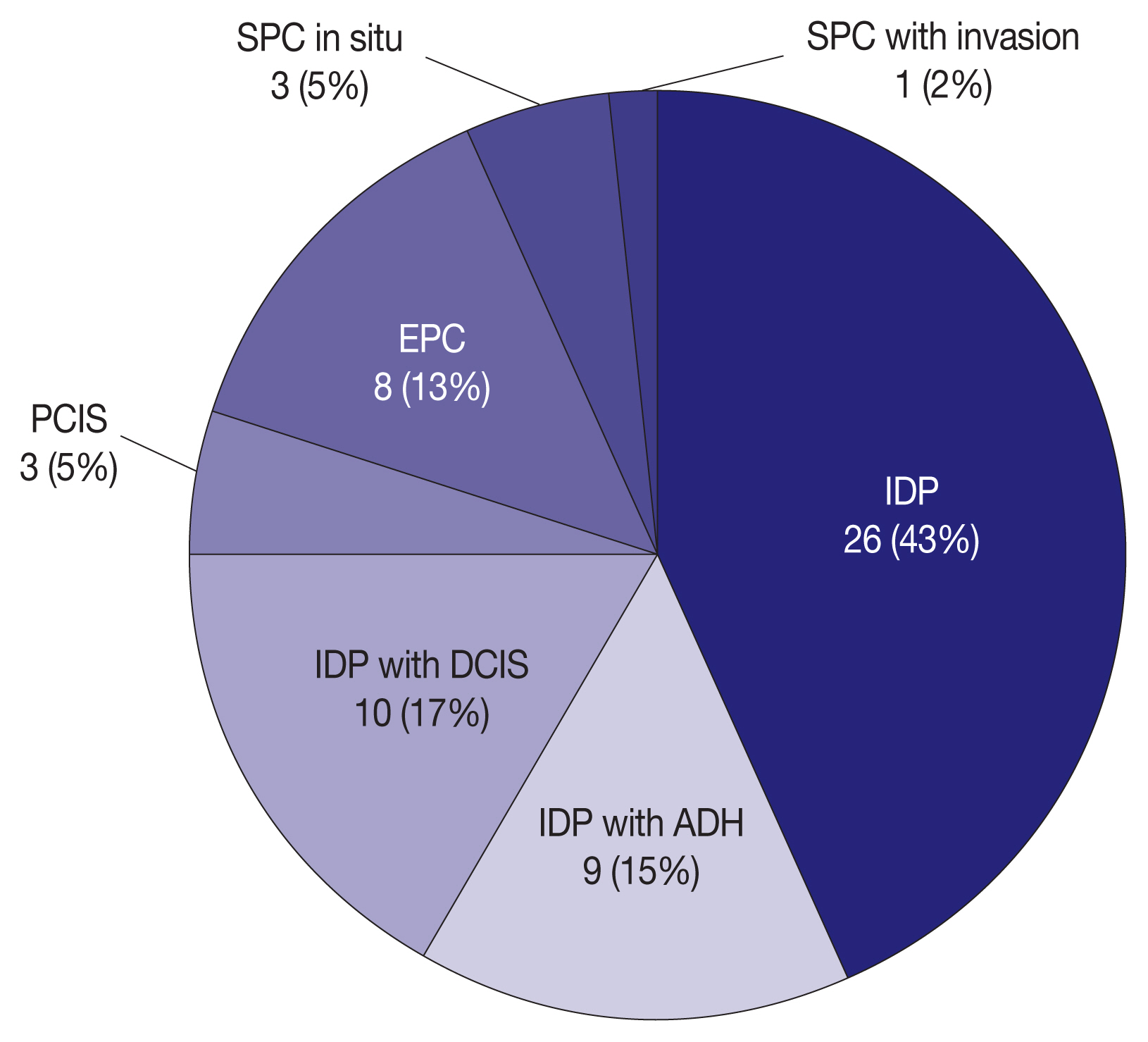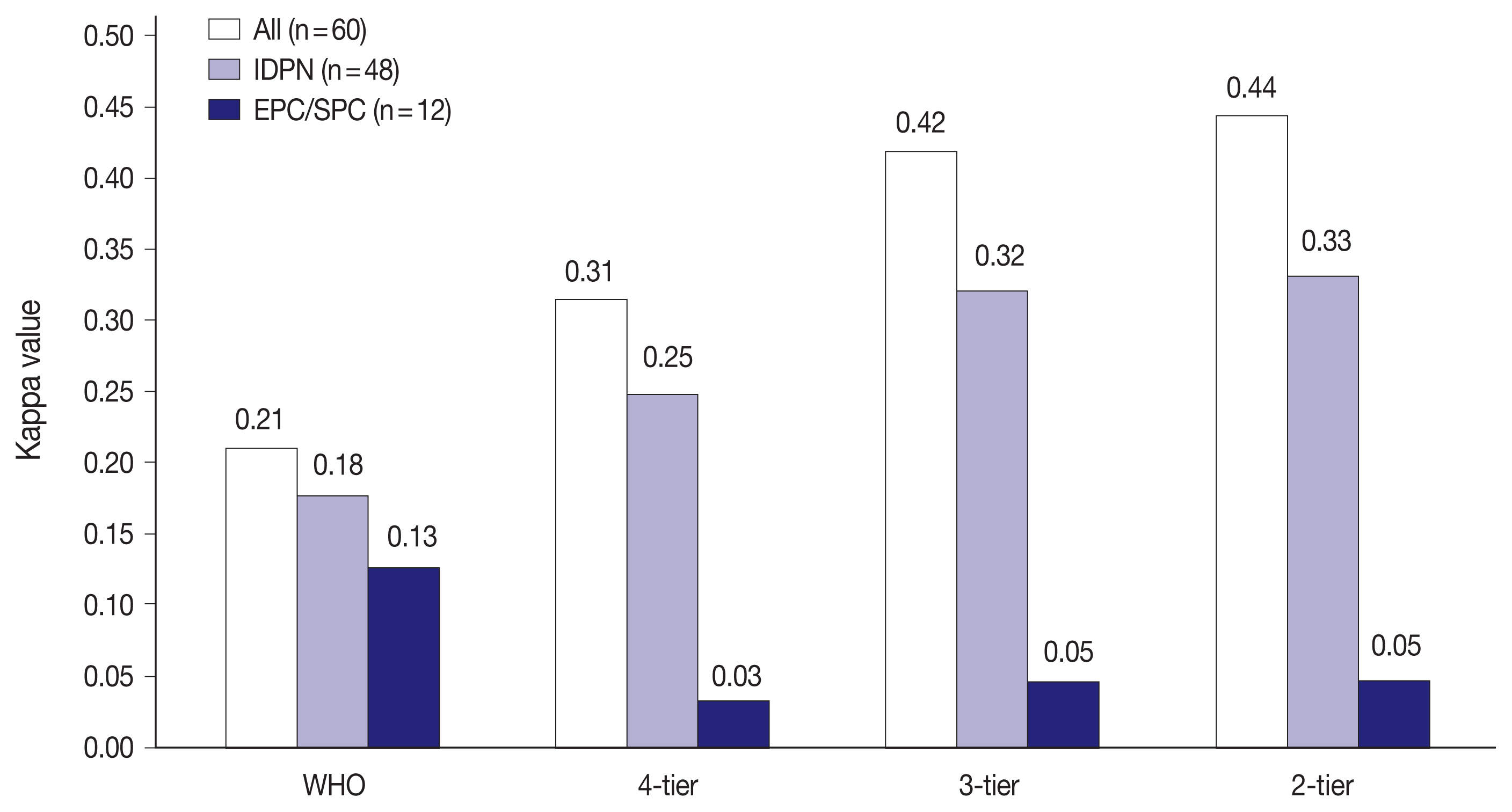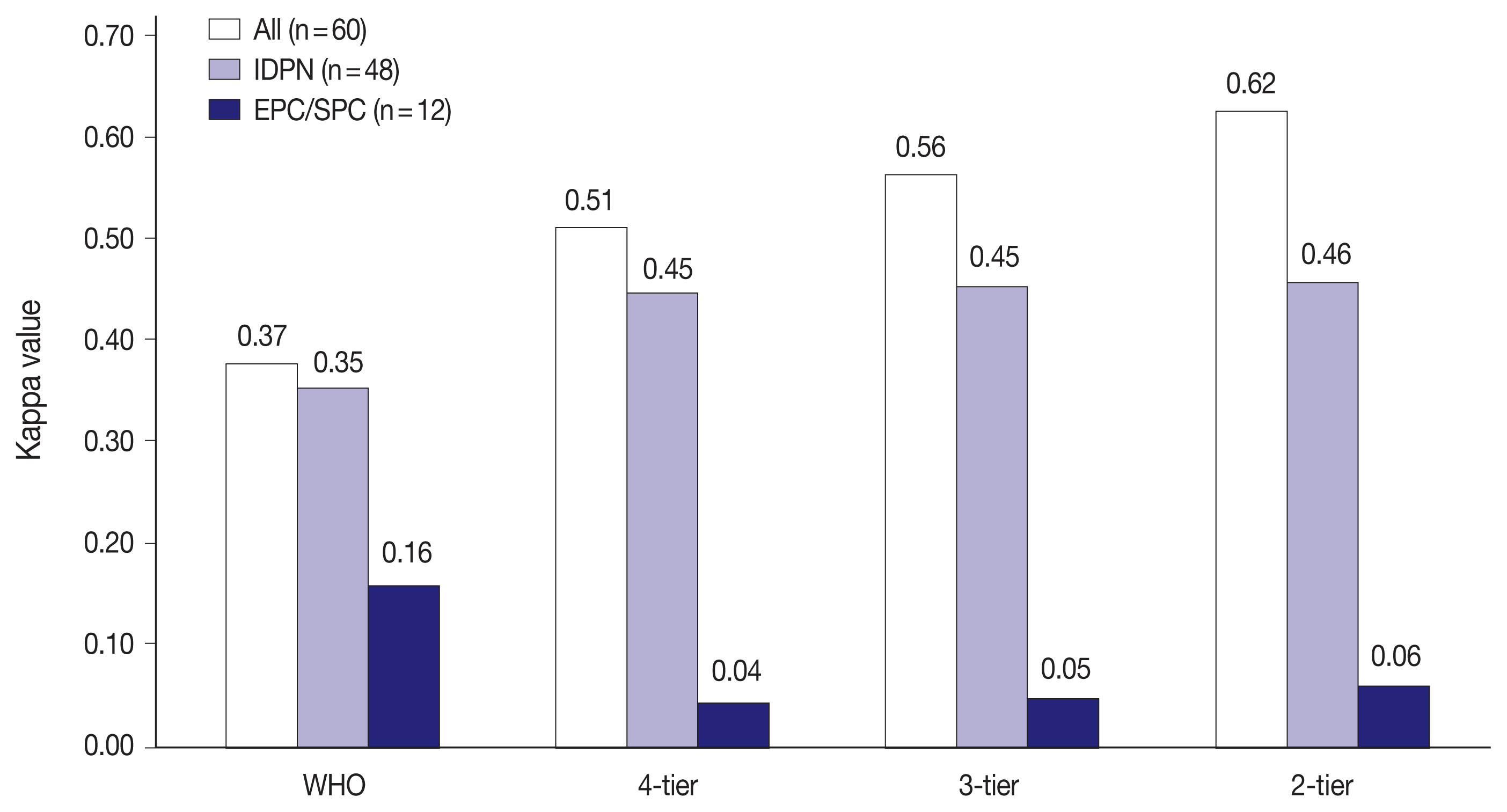Articles
- Page Path
- HOME > J Pathol Transl Med > Volume 55(6); 2021 > Article
-
Original Article
A multicenter study of interobserver variability in pathologic diagnosis of papillary breast lesions on core needle biopsy with WHO classification -
Hye Ju Kang1
 , Sun Young Kwon2
, Sun Young Kwon2 , Ahrong Kim3
, Ahrong Kim3 , Woo Gyeong Kim4
, Woo Gyeong Kim4 , Eun Kyung Kim5
, Eun Kyung Kim5 , Ae Ree Kim6
, Ae Ree Kim6 , Chungyeul Kim6
, Chungyeul Kim6 , Soo Kee Min7
, Soo Kee Min7 , So Young Park8
, So Young Park8 , Sun Hee Sung9
, Sun Hee Sung9 , Hye Kyoung Yoon10
, Hye Kyoung Yoon10 , Ahwon Lee11
, Ahwon Lee11 , Ji Shin Lee12
, Ji Shin Lee12 , Hyang Im Lee13
, Hyang Im Lee13 , Ho Chang Lee14
, Ho Chang Lee14 , Sung Chul Lim15
, Sung Chul Lim15 , Sun Young Jun16
, Sun Young Jun16 , Min Jung Jung17
, Min Jung Jung17 , Chang Won Jung18
, Chang Won Jung18 , Soo Youn Cho19
, Soo Youn Cho19 , Eun Yoon Cho19
, Eun Yoon Cho19 , Hye Jeong Choi20
, Hye Jeong Choi20 , So Yeon Park21
, So Yeon Park21 , Jee Yeon Kim22
, Jee Yeon Kim22 , In Ae Park23
, In Ae Park23 , Youngmee Kwon1
, Youngmee Kwon1
-
Journal of Pathology and Translational Medicine 2021;55(6):380-387.
DOI: https://doi.org/10.4132/jptm.2021.07.29
Published online: October 6, 2021
1Department of Pathology, National Cancer Center, Goyang, Korea
2Department of Pathology, Keimyung University Dongsan Medical Center, Daegu, Korea
3Department of Pathology, Pusan National University Hospital, Busan, Korea
4Department of Pathology, Inje University Haeundae Paik Hospital, Busan, Korea
5Department of Pathology, Eulji University Hospital, Seoul, Korea
6Department of Pathology, Korea University Guro Hospital, Seoul, Korea
7Department of Pathology, Hallym University Sacred Heart Hospital, Anyang, Korea
8Department of Pathology, MizMedi Hospital, Seoul, Korea
9Department of Pathology, Ewha Womans University Mokdong Hospital, Seoul, Korea
10Department of Pathology, Inje University Busan Paik Hospital, Busan, Korea
11Department of Pathology, Seoul St. Mary’s Hospital, College of Medicine, The Catholic University of Korea, Seoul, Korea
12Department of Pathology, Chonnam National University Hwasun Hospital, Hwasun, Korea
13Department of Pathology, Gyeongsang National University Changwon Hospital, Changwon, Korea
14Department of Pathology, Chungbuk National University Hospital, Cheongju, Korea
15Department of Pathology, Chosun University Hospital, Gwangju, Korea
16Department of Pathology, Incheon St. Mary’s Hospital, College of Medicine, The Catholic University of Korea, Incheon, Korea
17Department of Pathology, Kosin University Gospel Hospital, Busan, Korea
18Department of Pathology, Green Cross Laboratories, Yongin, Korea
19Department of Pathology, Sungkyunkwan University Samsung Medical Center, Seoul, Korea
20Department of Pathology, Ulsan University Hospital, Ulsan, Korea
21Department of Pathology, Seoul National University Bundang Hospital, Seongnam, Korea
22Department of Pathology, Pusan National University Yangsan Hospital, Yangsan, Korea
23Department of Pathology, Seoul National University Hospital, Seoul, Korea
- Corresponding Author: Youngmee Kwon, MD, PhD, Department of Pathology, National Cancer Center, 323 Ilsan-ro, Ilsandong-gu, Goyang 10408, Korea Tel: +82-31-920-1742, Fax: +82-31-920-1369, E-mail: ymk@ncc.re.kr
© 2021 The Korean Society of Pathologists/The Korean Society for Cytopathology
This is an Open Access article distributed under the terms of the Creative Commons Attribution Non-Commercial License (https://creativecommons.org/licenses/by-nc/4.0) which permits unrestricted non-commercial use, distribution, and reproduction in any medium, provided the original work is properly cited.
Figure & Data
References
Citations

- Beyond the benign: A rare case report of myxoid pleomorphic liposarcoma
Arslan Ahmad, Muhammad Ammar, Muhammad Hasnain Saleem Choudary, Muhammad Nouman Sadiq, Rana Uzair Ahmad, Nouman Aziz
Radiology Case Reports.2025; 20(5): 2500. CrossRef - Invasive papillary carcinoma of the breast
Shijing Wang, Qingfu Zhang, Xiaoyun Mao
Frontiers in Oncology.2024;[Epub] CrossRef - Recommendations for Performance Evaluation of Machine Learning in Pathology: A Concept Paper From the College of American Pathologists
Matthew G. Hanna, Niels H. Olson, Mark Zarella, Rajesh C. Dash, Markus D. Herrmann, Larissa V. Furtado, Michelle N. Stram, Patricia M. Raciti, Lewis Hassell, Alex Mays, Liron Pantanowitz, Joseph S. Sirintrapun, Savitri Krishnamurthy, Anil Parwani, Giovann
Archives of Pathology & Laboratory Medicine.2024; 148(10): e335. CrossRef - Encapsulated papillary carcinoma of the breast: A single institution experience
Liang Xu, Qixin Mao, Qiuming Liu, Yufeng Gao, Lihua Luo, Chungen Guo, Wei Qu, Ningning Yan, Yali Cao
Oncology Letters.2023;[Epub] CrossRef - High-risk and selected benign breast lesions diagnosed on core needle biopsy: Evidence for and against immediate surgical excision
Aparna Harbhajanka, Hannah L. Gilmore, Benjamin C. Calhoun
Modern Pathology.2022; 35(11): 1500. CrossRef
 PubReader
PubReader ePub Link
ePub Link-
 Cite this Article
Cite this Article
- Cite this Article
-
- Close
- Download Citation
- Close
- Figure



Fig. 1
Fig. 2
Fig. 3
| WHO | 4-tier | 3-tier | 2-tier |
|---|---|---|---|
| Intraductal papilloma | Benign | Benign | Benign |
| IDP with ADH | Atypical | ||
| IDP with DCIS | In situ | In situ | Malignant |
| IDP with LCIS | |||
| Papillary carcinoma in situ | |||
| Encapsulated papillary carcinoma | |||
| Solid papillary carcinoma | |||
| EPC with invasion | Invasive | Invasive | |
| SPC with invasion | |||
| Invasive papillary carcinoma |
| Diagnostic classification | H&E staining | IHC staining | ||
|---|---|---|---|---|
|
|
| |||
| κ | Agreement rate (%) | κ | Agreement rate (%) | |
| WHO | 0.21 | 47.0 | 0.37 | 60.5 |
| 4-tier | 0.31 | 63.3 | 0.51 | 76.4 |
| 3-tier | 0.42 | 76.7 | 0.56 | 84.3 |
| 2-tier | 0.44 | 80.0 | 0.62 | 87.5 |
| Challenging case | Challenging point (%) | Diagnosis (agreement rate, n/20) |
|---|---|---|
| Apocrine metaplasia | Benign (55) | IDP (30%, 6/20) |
| IDP with ADH (25%, 5/20) | ||
| Malignant (45) | IDP with DCIS (35%, 7/20) | |
| PCIS (10%, 2/20) | ||
| Flat epithelial atypia-like features | Benign (30) | IDP with ADH (30%, 6/20) |
| Malignant (70) | IDP with DCIS (35%, 7/20) | |
| PCIS (20%, 4/20) | ||
| EPC (15%, 3/20) | ||
| Large cystic pattern with fibrous capsule but no or rare myoepithelial cells | In situ (95) | IDP with DCIS (5%, 1/20) |
| PCIS (70%, 14/20) | ||
| EPC (20%, 4/20) | ||
| Invasive (5) | IPC (5%, 1/20) | |
| Solid multinodular pattern with smooth contours but no or rare myoepithelial cells | In situ (65) | EPC (5%, 1/20) |
| SPC in situ (60%, 12/20) | ||
| Invasive (35) | SPC invasive (30%, 6/20) | |
| IPC (5%, 1/20) | ||
| Solid multinodular and jigsaw pattern with ragged contours but no myoepithelial cells | In situ (75) | PCIS (20%, 4/20) |
| EPC (40%, 8/20) | ||
| SPC in situ (15%, 3/20) | ||
| Invasive (25) | SPC invasive (10%, 2/20) | |
| IPC (15%, 3/20) |
PBL, papillary breast lesion; WHO, World Health Organization; IDP, intraductal papilloma; ADH, atypical ductal hyperplasia; DCIS, ductal carcinoma in situ; LCIS, lobular carcinoma in situ; EPC, encapsulated papillary carcinoma; SPC, solid papillary carcinoma.
H&E, hematoxylin and eosin; IHC, immunohistochemistry; PBL, papillary breast lesion; WHO, World Health Organization classification; 4-tier, 4-tier classification; 3-tier, 3-tier classification; 2-tier, 2-tier classification.
IHC staining, immunohistochemical staining for CK5 and p63; IDP, intraductal papilloma; ADH, atypical ductal hyperplasia; DCIS, ductal carcinoma in situ; PCIS, papillary carcinoma in situ; EPC, encapsulated papillary carcinoma; IPC, invasive papillary carcinoma; SPC, solid papillary carcinoma.

 E-submission
E-submission








